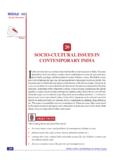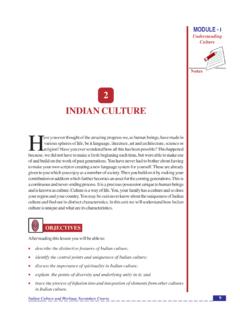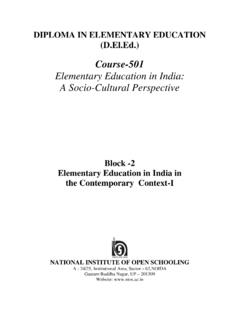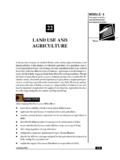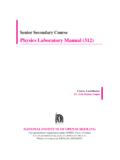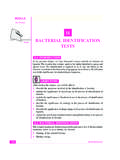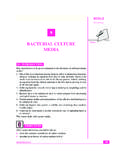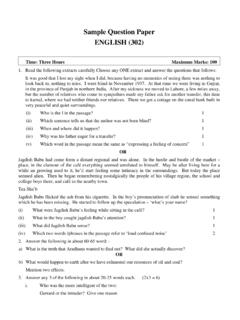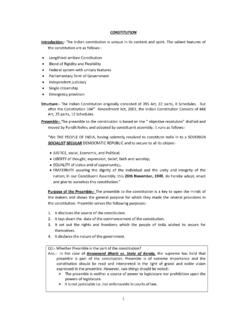Transcription of PREAMBLE AND THE SALIENT FEA TURES OF THE …
1 MODULE - 2 Notes44 Political ScienceAspects of theConstitution of India5 PREAMBLE AND THE SALIENTFEATURES OF THECONSTITUTION OF INDIAhe constitution of india was framed by a Constituent Assembly. This Assembly was anindirectly elected body. It had laid down certain ideals to be included in the ideals included commitment to democracy, guarantee to all the people of india -Justice, equality and freedom. It had also proclaimed that india will be a SovereignDemocratic constitution of india begins with a PREAMBLE contains the ideals,objectives and basic principles of the constitution . The SALIENT features of the Constitutionhave evolved directly and indirectly from these objectives which flow from the this lesson you will learn about the framing of the constitution , its political philosophy asreflected in the PREAMBLE and the SALIENT features of the studying this lesson you will be able to :lrecognize the significance of the constitution as the fundamental law of the land;ldescribe the composition of the Constituent Assembly and the role of the DraftingCommittee and the objectives of the Constituent Assembly;ldescribe the PREAMBLE to the constitution and its relevance.
2 Lidentify the basic principles of PREAMBLE and their reflection in the constitutionalprovisions;lidentify the main features of the constitution of india ;ldistinguish between a written and an unwritten, as well as a rigid and a flexibleconstitution;lanalyse the nature of the Indian constitution ;TMODULE - 2 Notes45 PREAMBLE and The SALIENT Features of The constitution of IndiaAspects of theConstitution of Indialestablish the importance of Fundamental Rights, Fundamental Duties and DirectivePrinciples of State policy; andlrecognize the special features that distinguish the Indian constitution from otherConstitutions of the The ConstitutionThe Modern State is considered to be a state for the welfare of the people.
3 It is therefore,suggested that it should have a government of a particular form with appropriate powersand document containing laws and rules which determine and describe the form of thegovernment, the relationship between the citizens and the government, is called such a constitution is concerned with two main aspects the relation between the differentlevels of government and between the government and the constitution is the basic fundamental law of a State. It lays down the objectives of theState which it has to achieve. It also provides for the constitutional framework that is,various structures and organs of the governments at different levels. In addition, it describesthe rights and duties of the citizens.
4 It is, therefore, considered to be the basis for thegovernance of the country both in terms of goals and objectives as also their structuresand The Constituent AssemblyThe constitution of india was framed by the Constituent Assembly. The Assembly wasconstituted in members of the Constituent Assembly were indirectly elected by the members of theexisting Provincial Assemblies. In addition, there were members nominated by the rulersof the Princely States. With Independence of india , the Constituent Assembly became afully sovereign Constituent Assembly, following the partition of the country in 1947, consisted of 299members as on 31st December 1947. Of these 229 members were elected by the provincialassemblies and the rest were nominated by the rulers of the princely states.
5 Majority ofthe members in the Constituent Assembly belonged to the Congress party. All prominentleaders of the freedom movement were members of the States During the British Rule there were about 560 areas which were notdirectly under the control of the British. These were Kingdoms or Riyasats underIndian rulers or Princes. These were called Princely States . To name a few, Kashmir,Patiala, Hyderabad, Mysore, Baroda were some of the princely Working of the Constituent AssemblyThe Constituent Assembly was chaired by the President of the Assembly Dr. RajendraPrasad was elected as the President of the Assembly. The Assembly worked with thehelp of a large number of committees and sub-committees.
6 The committees were of twoMODULE - 2 Notes46 Political ScienceAspects of theConstitution of Indiatypes : (a) relating to matters concerning with procedures, and (b) concerning importantissues. In addition there was an Advisory Committee primarily advised from outside. Themost important committee was the Drafting Committee. Dr. Ambedkar was theChairman of the Drafting Committee. The task of the Committee was to prepare the draftof the constitution . The Constitutent Assembly met for 166 days spread over a period of2 years 11months and 18 days. The procedure followed in the Assembly was Similar tothat which is followed in legislature. You will study about the legislative procedure in detailin subsequent lesson on Parliament and the legislative leaders of the Constituent Assembly were conscious that the need of the hour wasgeneral agreement on different issues and principles.
7 As a result, deliberate efforts weremade to achive consensus. While arriving at any decision, the aspirations of the peoplewere uppermost in the minds of the members of the Question out (PPPPP) the correct constitution of a country provides the basis fora)punishment of criminalsb)governance of the countryc)relationship between the citizensd)trade relations with other Constituent Assembly of india was composed of the members :a)nominated by the British )nominated by political )elected by Provincial Assemblies and nominees of the Princely ) elected by constitution of india was drafted by thea)Advisory CommitteeDr. Rajendra PrasadPresident of ConstituentAssemblyDr. Ambedkar, Chairmanof drafting committee ofconstitutionMODULE - 2 Notes47 PREAMBLE and The SALIENT Features of The constitution of IndiaAspects of theConstitution of Indiab)Secretariat of the Assemblyc)President of the Assemblyd)Drafting Objectives of The ConstitutionThe constitution of independent india was framed in the background of about 200 yearsof colonial rule, a mass-based freedom struggle, the national movement, partition of thecountry and spread of communal violence.
8 Therefore, the framers of the Constitutionwere concerned about the aspirations of the people, integrity and unity of the country andestablishment of a democratic society. Amongst the members there were some who helddifferent ideological views. There were others who were inclined to socialist principles,still others holding Gandhian thinking but nothing could act as any kind of impediment in theprogress of the Assembly s work because all these members were of liberal ideas. Theirmain aim was to give india a constitution which will fulfill the cherished ideas and idealsof the people of this Rajendra Prasad signing the new constitutionConscious efforts were made to have consensus on different issues and principles andthereby avoid disagreement.
9 The consensus came in the form of the Objectives Resolution moved by Jawahar Lal Nehru in the Constituent Assembly on December 17, 1946 whichwas almost unanimously adopted on January 22, 1947. In the light of these Objectives the Assembly completed its task by November 26, 1949. The constitution was enforcedwith effect from January 26, 1950. From that day india became a Republic. Exactlytwenty years before the first independence day was celebrated on Jan. 26, 1930 as decidedby the Lahore session of the Congress on Dec. 31, 1929. Hence, January 26, 1950 wasdecided as the day to enforce the The PreambleAs you know that the constitution of india commences with a PREAMBLE .
10 Let us find outMODULE - 2 Notes48 Political ScienceAspects of theConstitution of Indiawhat a PREAMBLE is. The PREAMBLE is like an introduction or preface of a book. As anintroduction, it is not a part of the contents but it explains the purposes and objectives withwhich the document has been written. So is the case with the PREAMBLE to the IndianConstitution. As such the PREAMBLE provides the guide lines of the of Indian ConstitutionThe PREAMBLE , in brief, explains the objectives of the constitution in two ways: one, aboutthe structure of the governance and the other, about the ideals to be achieved in independentIndia. It is because of this, the PREAMBLE is considered to be the key of the objectives, which are laid down in the PREAMBLE , are:i)Description of Indian State as Sovereign, Socialist, Secular, Democratic Republic.
